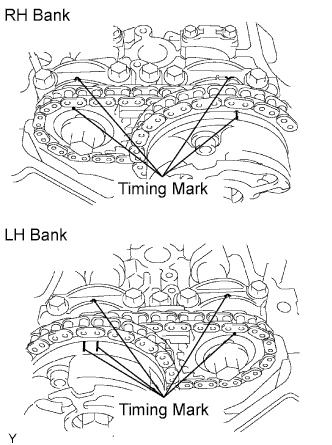CHECK VALVE TIMING (CHECK FOR LOOSE AND JUMPED TOOTH ON TIMING CHAIN)
DTC P0016 Crankshaft Position - Camshaft Position Correlation (Bank 1 Sensor A) |
DTC P0018 Crankshaft Position - Camshaft Position Correlation (Bank 2 Sensor A) |
DESCRIPTION
Refer to DTC P0335 (Toyota Fortuner RM000000TCW01BX.html).| DTC No. | DTC Detection Condition | Trouble Area |
| P0016 | Deviations in crankshaft and camshaft position sensor 1 signals (2 trip detection logic) |
|
| P0018 | Deviations in crankshaft and camshaft position sensor 2 signals (2 trip detection logic) |
|
MONITOR DESCRIPTION
The ECM optimizes the valve timing by using the Variable Valve Timing (VVT) system to control the intake valve camshaft. The VVT system includes the ECM, Oil Control Valve (OCV) and VVT controller.The ECM sends a target duty-cycle control signal to the OCV. This control signal, applied to the OCV, regulates the oil pressure supplied to the VVT controller. The VVT controller can advance or retard the intake valve camshaft. The ECM calibrates the intake valve timing by setting the intake camshaft to the most retarded angle while the engine is idling. The ECM closes the OCV to retard the cam. The ECM stores this value as the VVT learned value. When the difference between the target valve timing and actual valve timing is more than 5°of the crankshaft angle, the ECM learns it.
If the VVT learning value meets the following conditions, the ECM determines the existence of a malfunction in the VVT system, and sets the DTC.
- VVT learning value is less than 27°crankshaft angle, or more than 49°CA.
- Above condition continues for 18 seconds or more.
This monitor begins to run after the engine has idled for 5 minutes.
WIRING DIAGRAM
Refer to DTC P0335 (Toyota Fortuner RM000000TCW01BX.html).INSPECTION PROCEDURE
- HINT:
- Read freeze frame data using the intelligent tester. Freeze frame data records the engine conditions when malfunctions are detected. When troubleshooting, freeze frame data can help determine if the vehicle was running or stopped, if the engine was warmed up or not, if the air-fuel ratio was lean or rich, and other data from the time the malfunction occurred.
| 1.CHECK VALVE TIMING (CHECK FOR LOOSE AND JUMPED TOOTH ON TIMING CHAIN) |
 |
Remove the cylinder head cover.
Turn the crankshaft pulley, and align its groove with the timing mark "0" of the timing chain cover.
Check that the timing marks of the camshaft timing gears are aligned with the timing marks of the bearing cap as shown in the illustration.
If not, turn the crankshaft 1 revolution (360°), then align the marks as described above.- OK:
- Timing marks on camshaft timing gears are aligned as shown in the illustration.
|
| ||||
| OK | |
| 2.REPLACE ECM |
After replacing the ECM or adjusting intake valve timing, confirm that the DTC output does not recur.
Connect a intelligent tester to the DLC3.
Turn the ignition switch ON and turn the tester ON.
Clear DTCs (Toyota Fortuner RM0000010E700JX.html).
Change the ECM from normal mode to check mode using the tester (Toyota Fortuner RM000000PDL017X.html).
Start the engine and warm it up.
Allow the engine to idle for 1 minute or more, and then driver the vehicle for 1 minute or more.
Confirm that no DTC is set using the tester.
| NEXT | ||
| ||